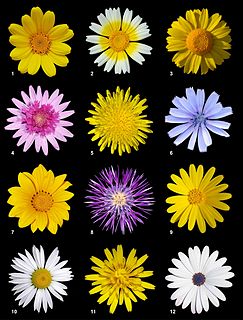
Asteraceae or Compositae, is a very large and widespread family of flowering plants (Angiospermae).

The Cucurbitaceae, also called cucurbits or the gourd family, are a plant family consisting of about 965 species in around 95 genera, of which the most important to humans are:

The Moraceae — often called the mulberry family or fig family — are a family of flowering plants comprising about 38 genera and over 1100 species. Most are widespread in tropical and subtropical regions, less so in temperate climates; however, their distribution is cosmopolitan overall. The only synapomorphy within the Moraceae is presence of laticifers and milky sap in all parenchymatous tissues, but generally useful field characters include two carpels sometimes with one reduced, compound inconspicuous flowers, and compound fruits. The family includes well-known plants such as the fig, banyan, breadfruit, mulberry, and Osage orange. The 'flowers' of Moraceae are often pseudanthia.

Petals are modified leaves that surround the reproductive parts of flowers. They are often brightly colored or unusually shaped to attract pollinators. Together, all of the petals of a flower are called a corolla. Petals are usually accompanied by another set of special leaves called sepals, that collectively form the calyx and lie just beneath the corolla. The calyx and the corolla together make up the perianth. When the petals and sepals of a flower are difficult to distinguish, they are collectively called tepals. Examples of plants in which the term tepal is appropriate include genera such as Aloe and Tulipa. Conversely, genera such as Rosa and Phaseolus have well-distinguished sepals and petals. When the undifferentiated tepals resemble petals, they are referred to as "petaloid", as in petaloid monocots, orders of monocots with brightly coloured tepals. Since they include Liliales, an alternative name is lilioid monocots.
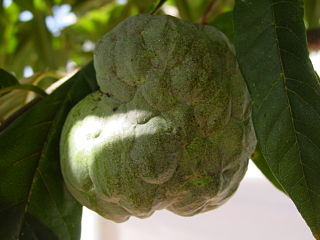
The Annonaceae are a family of flowering plants consisting of trees, shrubs, or rarely lianas commonly known as the custard apple family or soursop family. With 108 accepted genera and about 2400 known species, it is the largest family in the Magnoliales. Several genera produce edible fruit, most notably Annona, Anonidium, Asimina, Rollinia, and Uvaria. Its type genus is Annona. The family is concentrated in the tropics, with few species found in temperate regions. About 900 species are Neotropical, 450 are Afrotropical, and the remaining are Indomalayan.

Rhamnaceae is a large family of flowering plants, mostly trees, shrubs, and some vines, commonly called the buckthorn family. Rhamnaceae is included in the order Rosales.

Cymbidium, commonly known as boat orchids, is a genus of evergreen flowering plants in the orchid family Orchidaceae. Orchids in this genus are epiphytic, lithophytic, terrestrial or rarely leafless saprophytic herbs usually with pseudobulbs. There are usually between three and twelve leaves arranged in two ranks on each pseudobulb or shoot and lasting for several years. From one to a large number of flowers are arranged on an unbranched flowering stem arising from the base of the pseudobulb. The sepals and petals are all free from and similar to each other. The labellum is significantly different from the other petals and the sepals and has three lobes. There are about fifty-five species and sixteen further natural hybrids occurring in the wild from tropical and subtropical Asia to Australia. Cymbidiums are well known in horticulture and many cultivars have been developed.
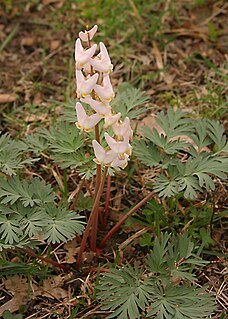
Dicentra, known as bleeding-hearts, is a genus of eight species of herbaceous plants with oddly shaped flowers and finely divided leaves, native to eastern Asia and North America.

Myosotis is a genus of flowering plants in the family Boraginaceae. The name comes from the Ancient Greek μυοσωτίς "mouse's ear", which the foliage is thought to resemble. In the northern hemisphere they are colloquially denominated forget-me-nots or scorpion grasses. The colloquial name "forget-me-not" was calqued from the German Vergissmeinnicht and first used in English in AD 1398 through King Henry IV of England. Similar names and variations are found in many languages. Myosotis alpestris is the official flower of Alaska and Dalsland, Sweden. Plants of the genus are commonly confused with Chatham Islands' forget-me-nots which belong to the related genus Myosotidium.

Menyanthaceae is a family of aquatic and wetland plants in the order Asterales. There are approximately 60-70 species in six genera distributed worldwide. The simple or compound leaves arise alternately from a creeping rhizome. In the submersed aquatic genus Nymphoides, leaves are floating and support a lax, umbellate or racemose inflorescence. In other genera the inflorescence is erect and consists of one to many flowers. The sympetalous, insect-pollinated flowers are five-parted and either yellow or white. The petals are ciliate or adorned with lateral wings. Fruit type is a capsule.

Zeuxine, commonly known as verdant jewel orchids, is a genus of about eighty species of orchids in the tribe Cranichideae. They are native to parts of tropical Africa, Asia, Southeast Asia, New Guinea, Australia and some Pacific Islands. They have relatively narrow, dark green leaves and small, dull-coloured resupinate flowers with the dorsal sepal and petals overlapping to form a hood over the column. The labellum has a pouched base and its tip has two lobes.

Dillenia is a genus of about 100 species of flowering plants in the family Dilleniaceae, native to tropical and subtropical regions of southern Asia, Australasia, and the Indian Ocean islands.
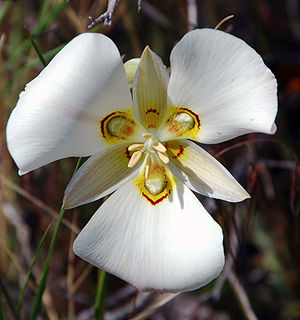
Calochortus nuttallii — known as sego lily — is a bulbous perennial which is endemic to the Western United States.

Cyrtostylis, commonly known as gnat orchids, is a genus of five or six species of flowering plants in the orchid family Orchidaceae and is native to Australia and New Zealand. Cyrtostylis orchids often form dense colonies of genetically identical plants. They have a single heart-shaped leaf and a thin flowering stem with pale coloured insect-like flowers. The lateral sepals and petals are similar in size and colour but the labellum is shelf-like and conspicuous with two prominent glands at its base.

Orophea is a genus of flowering plants in the family Annonaceae. There are about 37 species native to Asia.
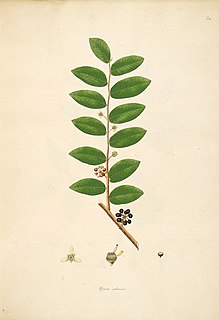
Polyalthia is a genus of flowering plants in the family Annonaceae. There are approximately 90 species distributed from Africa to Asia and the Pacific.

Lasiopetalum is a genus in the family Malvaceae containing around 35 species of shrub, which are native to Australia.

Euryomyrtus ramosissima, the rosy baeckea, is a shrub in the myrtle family (Myrtaceae). The species is endemic to Australia. It is spreading in habit and grows to 60 cm in height. Its leaves are dark green, long and narrow ranging from 3 to 13 mm in length and 1 to 3 mm in width. White, pink or mauve flowers with circular petals are produced between June and February in its native range.

Genoplesium commonly known as midge orchids, is a genus of about 50 species of flowering plants in the orchid family, Orchidaceae and is found in Australia, New Zealand and New Caledonia. Midge orchids are terrestrial herbs with a single leaf at the base of the plant. They are similar to orchids in the genus Prasophyllum in that plants without flowers have a hollow, onion-like leaf. The flowers are small but often scented and attractive to their insect pollinators. There is disagreement about which species belong to this genus and some taxonomists suggest that most belong in the genus Corunastylis.
Mitrephora maingayi is a species of plant in the family Annonaceae. It is native to Bangladesh, Cambodia, Laos, Myanmar, Thailand, and Vietnam. Joseph Hooker and Thomas Thomson, the British botanists who first formally described the species, named it after the dense hair covering its young branches, leaves and flowers.



















